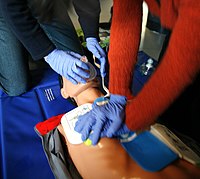
Photo from wikipedia
Abstract Objectives: Studies have demonstrated the efficacy of mechanical devices at delivering high-quality cardiopulmonary resuscitation (HQ-CPR) in various transport settings. Herein, this study investigates the efficacy of manual and mechanical… Click to show full abstract
Abstract Objectives: Studies have demonstrated the efficacy of mechanical devices at delivering high-quality cardiopulmonary resuscitation (HQ-CPR) in various transport settings. Herein, this study investigates the efficacy of manual and mechanical HQ-CPR delivery on a fire rescue boat. Methods: A total of 15 active firefighter-paramedics were recruited for a prospective manikin-based trial. Each paramedic performed two minutes manual compression-only CPR while navigating on a river-based fire rescue boat. The boat was piloted in either a stable linear manner or dynamic S-turn manner to simulate obstacle avoidance. For each session of manual HQ-CPR, a session of mechanical HQ-CPR was also performed with a LUCAS 3 (Stryker; Kalamazoo, Michigan USA). A total of 60 sessions were completed. Parameters recorded included compression fraction (CF) and the percentage of compressions with correct depth >5cm (D%), correct rate 100-120 (R%), full release (FR%), and correct hand position (HP%). A composite HQ-CPR score was calculated as follows: ((D% + R% + FR% + HP%)/4) * CF%). Differences in magnitude of change seen in stable versus dynamic navigation within study conditions were evaluated with a Z-score calculation. Difficulty of HQ-CPR delivery was assessed utilizing the Borg Rating of Perceived Exertion Scale. Results: Participants were mostly male and had a median experience of 20 years. Manual HQ-CPR delivered during stable navigation out-performed manual HQ-CPR delivered during dynamic navigation for composite score and trended towards superiority for FR% and R%. There was no difference seen for any measured variable when comparing mechanical HQ-CPR delivered during stable navigation versus dynamic navigation. Mechanical HQ-CPR out-performed manual HQ-CPR during both stable and dynamic navigation in terms of composite score, FR%, and R%. Z-score calculation demonstrated that manual HQ-CPR delivery was significantly more affected by drive style than mechanical HQ-CPR delivery in terms of composite HQ-CPR score and trended towards significance for FR% and R%. Borg Rating of Perceived Exertion was higher for manual CPR delivered during dynamic sessions than for stable sessions. Conclusion: Mechanical HQ-CPR delivery is superior to manual HQ-CPR delivery during both stable and dynamic riverine navigation. Whereas manual HQ-CPR delivery was worse during dynamic transportation conditions compared to stable transport conditions, mechanical HQ-CPR delivery was unaffected by drive style. This suggests the utility of routine use of mechanical HQ-CPR devices in the riverine patient transport setting.
Journal Title: Prehospital and Disaster Medicine
Year Published: 2022
Link to full text (if available)
Share on Social Media: Sign Up to like & get
recommendations!